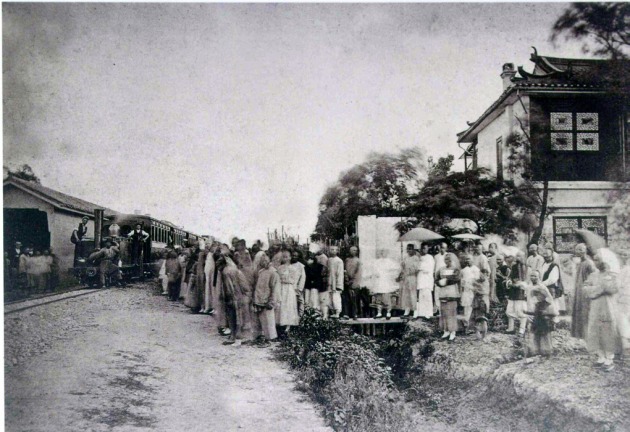Not that Chairman, but Henry John Howard Tripp, Chairman of the Shanghai Recreation Club in 1897. A long-time resident of Shanghai, where he worked as agent for the Mitsui Bishi Company (having previously lived in Japan), Tripp was a keen (if apparently not brilliant) sportsman, a sometime jiujitsu practitioner, and an energetic chair who had the recreation ground — which sat within the Shanghai Race Club track — cleared of Chinese grave mounds. So Cape Town-born Tripp left his mark on Shanghai’s landscape, but he also left it, quite inadvertently, in the literature on the history of Chinese cinema.
How so? Well, some accounts of the history of the arrival of film in China state that the first scenes filmed in China were screened on 5 August 1897 at the Shanghai Recreation Ground. Tripp was most likely to be the Chairman of the evening’s events. A trio of entrepreneurs, scenting opportunity, were touring the larger foreign communities in China, giving exhibitions of films using the newly Cinematograph and Animatoscope equipment. Film historians have been assiduous in tracking down reports of their movements and shows, combing English-language and Chinese newspapers, noting audience reactions and diligently matching the descriptions given of the films with the known body of work being produced in Europe. The first screening in Shanghai seems to have been at the Astor House Hotel on Saturday 22 May 1897 and we have excited and detailed reports about this and other shows, with lists of film titles and descriptions of the machinery.
What is most striking is the suggestion that these machines were being used to film, as well as to project. And so in the literature you can find accounts of performances which note also that on 5 August 1897 some shorts filmed in Shanghai were shown to the audience at the Recreation Club. The titles were: ‘The Arrival of the First Train from Woosung’, ‘The Meet of the Shanghai Bicyclist Association’, ‘Workmen Leaving the Shanghai Engine Works’, and ‘Diving at the Shanghai Swimming Bath’. So, it seems, cinema history was made in what would in time become China’s movie-making capital, and a city much mythologised on the silver screen. The source is a report of the event in the North China Herald published on 13 August 1897. The evening, we are told, was a great success, and culminated with the assembled company singing songs. Having recounted all this (barring the singing) — a report that other scholars have relied on and repeated — one history asks: ‘But who made those films?’

‘The arrival of the first train from Woosung’ (1897) … ? Hmm
Well, the answer, in a sense, is probably Henry John Howard Tripp. For the report has more than once been been misread. No films shot in Shanghai were shown that hot August night in Shanghai. Instead, we are told that ‘much amusement’ was ’caused by the Chairman wittily giving his own titles to the pictures shown’. And so Shanghai was given ‘a peep into the future’, and ‘Workmen Leaving Portsmouth Dockyard’ became in his words ‘Workmen Leaving the Shanghai Engine Works’, while one of the Lumière Brothers films showing the arrival of a train became ‘The Arrival of the First Train from Woosung’. Very droll, especially the latter, for it was noticed that the conductors and passengers were all European.
Droll but confusing for some, and Tripp’s joke became a statement of fact, and the cheerful night a landmark event in the onward march of film-making in China. So the first film footage shot in China was instead that which we know to have been shown on Saturday 18 September at the Lyceum Theatre in the city. (First, that is, if we are to rely on this the first comment in this vein in China’s English-language press). The audience that night was small, for perhaps the novelty was wearing off: there had been complaints about the way the Animatoscope vibrated, and that while people seemed to be rendered faithfully, something very funny happened to turning wheels. But in amongst the other shorts of the procession in London to mark Queen Victoria’s Jubilee (which had brought an earlier audience to its feet to sing the National Anthem) ‘the most novel feature was a view of the Bubbling Well Road, in the neighbourhood of the Recreation Ground, which had to be shown twice in response to the demand of the audience’. We are told that ‘the proprietors hope to be able to show some more views of Shanghai in the course of a day or two’.

Lumière Brothers, Arrival of a Train at La Ciotat train station (1896)
So I hope that this is now cleared up. Although of course, I do not know for sure that it was Tripp himself who presided on 5 August. It seems a reasonable supposition but might, however, be yet another red herring. Over to you.
And here, just for the record, is a photograph of the first train from Woosung.

Shanghai-Wusong railroad opening ceremony, 1876, Source Virtual Shanghai.
Sources: North China Herald, 13 August 1897, p. 296; 10 September 1897, p. 498; 6 April 1912, p. 16.
Bibliography
Cheng Jihua (ed.), Zhongguo dianying fazhanshi (Beijing: Zhongguo dianying chubanshe, 1963).
Law Kar and Frank Bren, Hong Kong Cinema: A Cross-cultural View (Lanham: Scarecrow Press, 2004), pp. 17-18, p. 307.
Matthew D. Johnson, ‘International and wartime origins of the propaganda state : the motion picture in China, 1897-1955’ (University of California San Diego, PhD thesis, 2008), p. 38.
Huang Xuelei, Shanghai Filmmaking: Crossing Borders, Connecting to the Globe, 1922-1938 (Leiden: Brill, 2014), pp. 143-44.
